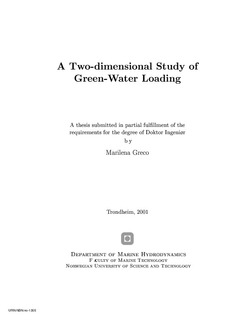| dc.contributor.author | Greco, Marilena | nb_NO |
| dc.date.accessioned | 2014-12-19T11:24:53Z | |
| dc.date.available | 2014-12-19T11:24:53Z | |
| dc.date.created | 2001-09-28 | nb_NO |
| dc.date.issued | 2001 | nb_NO |
| dc.identifier | 125461 | nb_NO |
| dc.identifier.isbn | 82-471-5334-3 | nb_NO |
| dc.identifier.uri | http://hdl.handle.net/11250/231252 | |
| dc.description.abstract | Large relative motions between the ship and the water may cause water shipping on the main deck. In this thesis, the fundamental features of water-on-deck phenomena are in vestigated, together with the "green" water loading on a deck house in the bow region. The studies are relevant for a stationary ship like a FPSO in head sea waves.
Potential flow theory is used to study numerically a nonlinear two-dimensional problem in a plane containing the ship's centerplane. The developed model is verified by various test cases, and validated by published as well as new experimental data.
The influence of wave parameters, ship motions and hull geometry is investigated. Relevance of three-dimensional effects is discussed.
Dedicated two-dimensional model tests have been performed, both to elucidate the fluid mechanics involved in the water shipping and to validate the numerical method. It is found that the water shipping starts in the form of a plunging wave hitting the deck. This could cause structural damages. Most often, the plunging is localized in the bow region and do not affect the main flow at a later stage. In a few cases, larger masses of water bluntly impacting with the deck have been observed. The latter is consistent with seldom observations reported in 3-D experiments, with large and steep waves plunging directly onto the deck. More often the water flow along the deck resembles the one subsequent to a dam breaking. Both types of events are investigated numerically. The impact pressures on a vertical wall in the bow area are measured and compare well with the boundary element method.
The reliability of a dam-breaking model and shallow-water approximation to study the propagation of water on the deck is examined. The former can only qualitatively describe the flow evolution.The latter can in principle be used but needs information from the exterior flow and, thus, the solution of the complete ship-waveinteraction problem.
Water impacts with a deck house in the bow area are studied in details. Use of a similarity solution for a water wedge hitting a rigid wall at 90º is compared with the fully numerical solution. The method predicts correctly the first stages of the impact with a smaller computational effort. Inuence of local flow conditions and wall slope on hydrodynamic loads is discussed. Importance of hydroelasticity is investigated in case of realistic structural parameters for the deck house. This shows a limited role of structural deformations in determining the maximum loads. | nb_NO |
| dc.language | eng | nb_NO |
| dc.publisher | Fakultet for ingeniørvitenskap og teknologi | nb_NO |
| dc.relation.ispartofseries | Dr. ingeniøravhandling, 0809-103X; 2001:70 | nb_NO |
| dc.title | A Two-Dimensional Study of Green-Water Loading | nb_NO |
| dc.type | Doctoral thesis | nb_NO |
| dc.source.pagenumber | 150 | nb_NO |
| dc.contributor.department | Norges teknisk-naturvitenskapelige universitet, Fakultet for ingeniørvitenskap og teknologi | nb_NO |
| dc.description.degree | dr.ing. | nb_NO |
| dc.description.degree | dr.ing. | en_GB |
